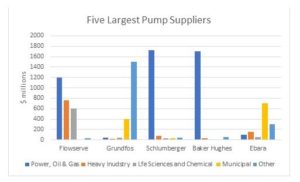Pump Market Primed for Growth in 2012
A new report on the UK pump market from MTW Research has identified a number of opportunities for pump manufacturers to
exploit in 2012, prompting optimism for growth in a number of key end use markets for pumps by the end of the year.
Against a backdrop of above-inflation growth forecast from 2013, the report discusses the changing nature of the pump market in recent years, suggesting that manufacturers continue to identify and react quickly to the changing market conditions. MTW highlight this as a key industry strength and with the recent swings in terms of public investment significantly impacting pump manufacturers’ marketing strategies, the need for suppliers to be able to adapt quickly to market volatility remains vital.
Despite moderate growth forecast for this year, MTW admit that the UK economy is not out of the woods yet with GDP growth unlikely to offer any real stimulus for the pump market until late 2012. However, the report reviews 11 end use sectors in some detail and identifies a number as offering some opportunity for either value or volume growth in the near–medium term. Opportunities identified by MTW include the WaSCs transfer of 30,000 pumping stations in the water supply & treatment sector; the impact of the 2nd Annual Energy Statement in November 2011 on the electricity generation sector; and the 8,500 new products which are introduced each year by food and drink manufacturers to name but a few. Within the oil and gas sector, the report suggests that both volume and value growth should be derived from smaller field applications, further impacting on the dynamics of the established market.
Pump procurement and specification has undergone some significant changes in recent years, and MTW points to computers and software having an increasing impact on what was historically a mechanical industry. The growth in VSDs which offer greater control and efficiency and the use of enhanced software for pump specification are just two of the key issues identified. These are set to grow in significance in the near term and will either enhance or diminish a manufacturers’ ability to add value – depending on how these changes are embraced by the pump market.
Based on industry sales, the report finds that 75% of pump manufacturers experienced some growth in the last 12 months, prompting optimism in the industry overall and suggesting that liquidity and profitability is improving throughout the industry. Some 86% of UK pump manufacturers have either a ‘good’ or ‘excellent’ credit rating according to MTW, though the report also sounds a note of caution by highlighting high borrowing levels throughout much of the pump market. Total borrowing by the UK pump industry currently stands at an estimated £1.1 billion in 2012. Between 2006 and 2012, overall debt increased by 51%, which MTW suggest reflects the rapid demand in borrowing requirements as profitability and sales came under increasing pressure.
Nevertheless, the report offers much in the way of optimism for the UK pump market with a more positive trading environment and growing demand from a number of end use application sectors forecast for the near term. The market is set to strengthen further in the medium to longer term, stimulated by a number of political, environmental, technological and economic influences with MTW forecasting sales of pumps to grow by around 10% over the next 5 years. The 130+ page report is available now from MTW Research’s website for £565.
Source: MTW Research Ltd






